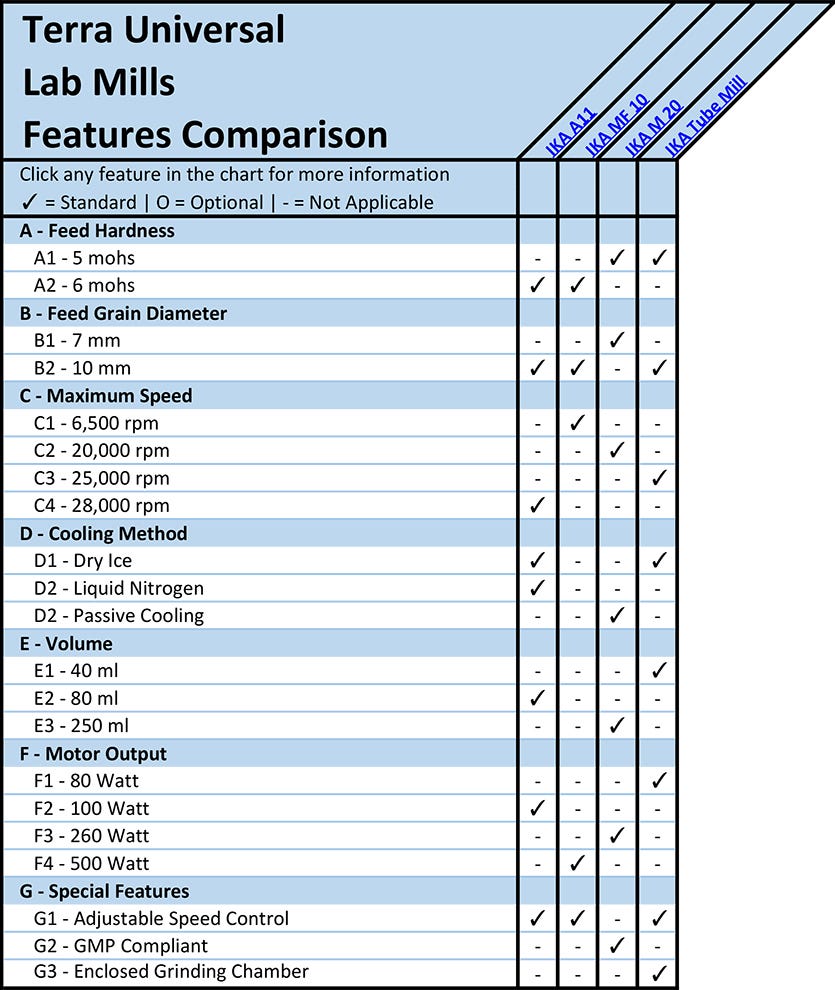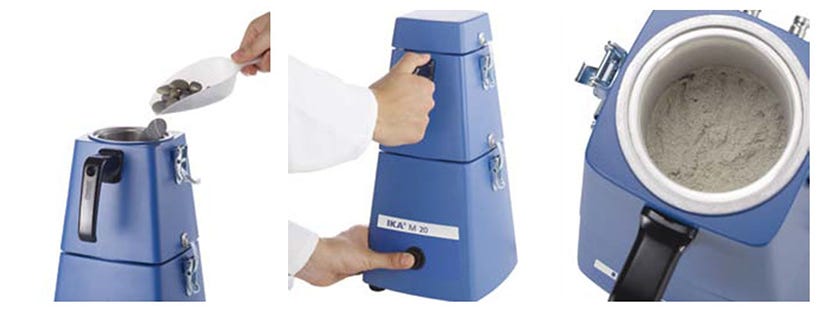
Laboratory mills, or laboratory mill grinders, utilize mechanical force to pulverize non-homogenous, batch samples into smaller, representative, homogenous samples for analytical and quality control testing. Mills are composed of a grinding element, such as a beater or cutting blade, housed within a stainless steel or disposable plastic milling chamber. The grinding element is connected to a high-speed motor regulated by a timer or digital controller.
What are Laboratory Mills Used For?
Lab grinding mills are designed to accommodate a variety of grinding elements for samples with different physical properties: dry, elastic, wet, hard, brittle and fibrous.
Impact mills are optimal for grinding hard, brittle or dried feed materials, such as grain, barley, cellulose, pharmaceuticals, resins and seeds.
Cutting mills are optimal for grinding elastic, fibrous, and soft feed materials, such as spices, hops, paper, plastics, and roots. Jaw crushers utilize a fixed and movable jaw for high-pressure crushing of glass and coal.
Analytical mills are commonly used for impact grinding of frozen food and vegetation.
Mortar grinders are used to pulverize dry or suspended organic samples, like homogenized pastes or creams.
Bead mills are optimal for shearing cell and tissue culture sample preparations.
A - Laboratory Mill Feed Sample Hardness
(back to chart)
The Mohs Hardness Scale charts the relative hardness, or scratch resistance, of various materials from 1 (softest) to 10 (hardest). The hardness test is typically performed by pressing a loaded indenter object onto the surface of the test material to measure the size of the lasting impression. Examples of 5-Mohs materials include bone, iron, enamel, glass and titanium. Common 6-Mohs materials include steel, silica, porcelain, and zirconium.
B - Feed Grain Sample Diameter
(back to chart)
The particle size, or grain diameter, of the sample material governs the selection of the appropriate laboratory mill.
IKA’s M20 model specializes in pulverizing small-particle samples up to 7mm in diameter while IKA’s MF10 system accommodates large-particle samples up to 10mm in diameter.
C - Maximum Laboratory Mill Speed
(back to chart)
The maximum grinding speed, stated in revolutions per minute (RPM), defines the optimal sample types for each mill.
IKA’s MF10 models have a speed range of 3,000 to 6,500 rpm, designed for pharmacy samples, like vitamins, tablets, and roots, as well as rubbers and plastics.
IKA M20 models maintain a fixed speed of 20,000 rpm for pulverizing grain, seeds, ceramics, salt and active carbon.
IKA Tube Mills feature a speed range of 5,000 to 25,000 rpm, crushes stems, leaves, tobacco, ginger, flowers, drug capsules and enzyme powder.
IKA A11 models have a fixed speed of 28,000 rpm to grind cellulose, resin, animal feed, spices, coal and detergents.
D - Laboratory Mill Cooling Method
(back to chart)
Effective sample preparation prior to milling ensures maximal grinding efficiency and mitigates instrument wear-and-tear. Elastic or fibrous samples, such as rubber and plant materials, are frozen over dry ice prior to grinding. Biological samples, such as nucleic acids and proteins, are cryogenically frozen in liquid nitrogen before milling. To prevent damage to the unit, wet samples are passively cooled and dried before milling to prevent adhesion to grinding elements.
E - Laboratory Mill Volume
Low-throughput models are designed to accommodate sample volumes down to 40 ml while high-throughput models process samples up to 250 ml in volume.
F - Laboratory Mill Motor Output
(back to chart)
IKA’s portfolio of laboratory mills and grinders include low-power models with 80-Watt motors and high-power models with 500-Watt motors. IKA’s standard units include protection mechanisms such as emergency-stop switches, overheating alarms, and grinding enclosures to prevent operator exposure.
G - Special Laboratory Grinding Features
(back to chart)
G1 - Lab Mills with Adjustable Speed Controls
Certain models include rotary dials to adjust current mixing speed, target mixing speed, and mixing time.
IKA Tube Mill Control includes a touch-screen keypad and LED display of real-time mixing conditions.
G2 - GMP Compliant Lab Mills
IKA M20 mill includes a removable, easy-to-clean, steel grinding chamber and USB interface for safe data export.
G3 - Enclosed Mill Grinding Chamber
IKA Tube Mill Control includes an enclosed, plastic grinding chamber for sample and operator protection. The disposable grinding chamber can be removed and used for long-term sample storage.
Where Can I Buy Laboratory Mills and Grinding Equipment Mills Online?
Laboratory-Equipment.com is a specialty division of Terra Universal. For nearly 40 years, Terra Universal has served semiconductor, aerospace, life science, pharmaceutical, biotechnology, and medical device markets. Customers appreciate a worldwide network of reps, factory-direct support, and ready-to-ship items available from Terra's manufacturing and warehouse facilities in Fullerton, California.
Shop online to compare pricing, features, and selection for a wide variety of laboratory mills and grinders for impact, cutting, analysis, beads, and mortar.



